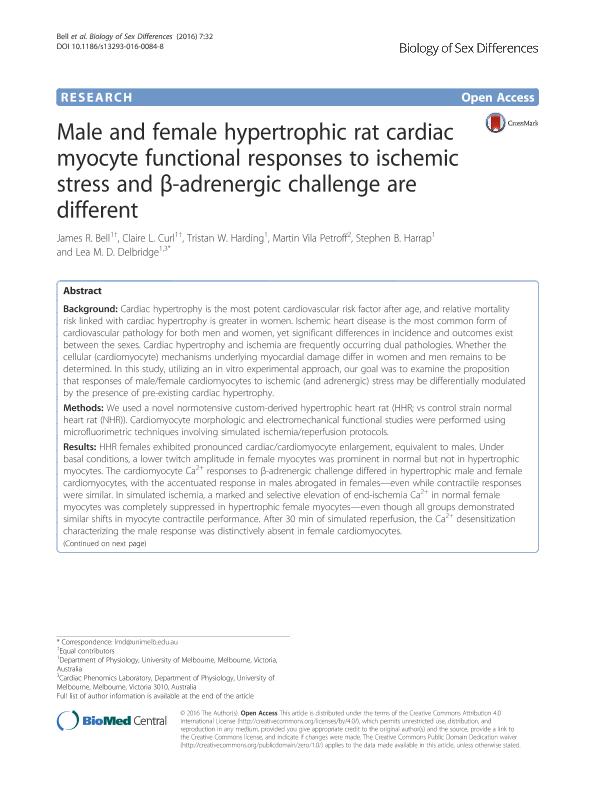Mostrar el registro sencillo del ítem
dc.contributor.author
Bell, James R.
dc.contributor.author
Curl, Claire L.
dc.contributor.author
Harding, Tristan W.
dc.contributor.author
Vila Petroff, Martin Gerarde

dc.contributor.author
Harrap, Stephen B.
dc.contributor.author
Delbridge, Lea M. D.
dc.date.available
2018-08-03T18:44:41Z
dc.date.issued
2016-07
dc.identifier.citation
Bell, James R.; Curl, Claire L.; Harding, Tristan W.; Vila Petroff, Martin Gerarde; Harrap, Stephen B.; et al.; Male and female hypertrophic rat cardiac myocyte functional responses to ischemic stress and β-adrenergic challenge are different; BioMed Central; Biology of Sex Differences; 7; 1; 7-2016; 1-15
dc.identifier.issn
2042-6410
dc.identifier.uri
http://hdl.handle.net/11336/54113
dc.description.abstract
Background: Cardiac hypertrophy is the most potent cardiovascular risk factor after age, and relative mortality risk linked with cardiac hypertrophy is greater in women. Ischemic heart disease is the most common form of cardiovascular pathology for both men and women, yet significant differences in incidence and outcomes exist between the sexes. Cardiac hypertrophy and ischemia are frequently occurring dual pathologies. Whether the cellular (cardiomyocyte) mechanisms underlying myocardial damage differ in women and men remains to be determined. In this study, utilizing an in vitro experimental approach, our goal was to examine the proposition that responses of male/female cardiomyocytes to ischemic (and adrenergic) stress may be differentially modulated by the presence of pre-existing cardiac hypertrophy. Methods: We used a novel normotensive custom-derived hypertrophic heart rat (HHR; vs control strain normal heart rat (NHR)). Cardiomyocyte morphologic and electromechanical functional studies were performed using microfluorimetric techniques involving simulated ischemia/reperfusion protocols. Results: HHR females exhibited pronounced cardiac/cardiomyocyte enlargement, equivalent to males. Under basal conditions, a lower twitch amplitude in female myocytes was prominent in normal but not in hypertrophic myocytes. The cardiomyocyte Ca2+ responses to β-adrenergic challenge differed in hypertrophic male and female cardiomyocytes, with the accentuated response in males abrogated in females - even while contractile responses were similar. In simulated ischemia, a marked and selective elevation of end-ischemia Ca2+ in normal female myocytes was completely suppressed in hypertrophic female myocytes - even though all groups demonstrated similar shifts in myocyte contractile performance. After 30 min of simulated reperfusion, the Ca2+ desensitization characterizing the male response was distinctively absent in female cardiomyocytes. Conclusions: Our data demonstrate that cardiac hypertrophy produces dramatically different basal and stress-induced pathophenotypes in female- and male-origin cardiomyocytes. The lower Ca2+ operational status characteristic of female (vs male) cardiomyocytes comprising normal hearts is not exhibited by myocytes of hypertrophic hearts. After ischemia/reperfusion, availability of activator Ca2+ is suppressed in female hypertrophic myocytes, whereas sensitivity to Ca2+ is blunted in male hypertrophic myocytes. These findings demonstrate that selective intervention strategies should be pursued to optimize post-ischemic electromechanical support for male and female hypertrophic hearts.
dc.format
application/pdf
dc.language.iso
eng
dc.publisher
BioMed Central

dc.rights
info:eu-repo/semantics/openAccess
dc.rights.uri
https://creativecommons.org/licenses/by-nc-sa/2.5/ar/
dc.subject
Cardiac Hypertrophy
dc.subject
Cardiomyocyte
dc.subject
Ischemia/Reperfusion
dc.subject
Sex/Gender
dc.subject
Stress Response
dc.subject.classification
Inmunología

dc.subject.classification
Medicina Básica

dc.subject.classification
CIENCIAS MÉDICAS Y DE LA SALUD

dc.title
Male and female hypertrophic rat cardiac myocyte functional responses to ischemic stress and β-adrenergic challenge are different
dc.type
info:eu-repo/semantics/article
dc.type
info:ar-repo/semantics/artículo
dc.type
info:eu-repo/semantics/publishedVersion
dc.date.updated
2018-06-07T17:56:11Z
dc.journal.volume
7
dc.journal.number
1
dc.journal.pagination
1-15
dc.journal.pais
Estados Unidos

dc.description.fil
Fil: Bell, James R.. University of Melbourne; Australia
dc.description.fil
Fil: Curl, Claire L.. University of Melbourne; Australia
dc.description.fil
Fil: Harding, Tristan W.. University of Melbourne; Australia
dc.description.fil
Fil: Vila Petroff, Martin Gerarde. Consejo Nacional de Investigaciones Científicas y Técnicas. Centro Científico Tecnológico Conicet - la Plata. Centro de Investigaciones Cardiovasculares ; Argentina
dc.description.fil
Fil: Harrap, Stephen B.. University of Melbourne; Australia
dc.description.fil
Fil: Delbridge, Lea M. D.. University of Melbourne; Australia
dc.journal.title
Biology of Sex Differences
dc.relation.alternativeid
info:eu-repo/semantics/altIdentifier/doi/http://dx.doi.org/10.1186/s13293-016-0084-8
dc.relation.alternativeid
info:eu-repo/semantics/altIdentifier/url/https://bsd.biomedcentral.com/articles/10.1186/s13293-016-0084-8
Archivos asociados
